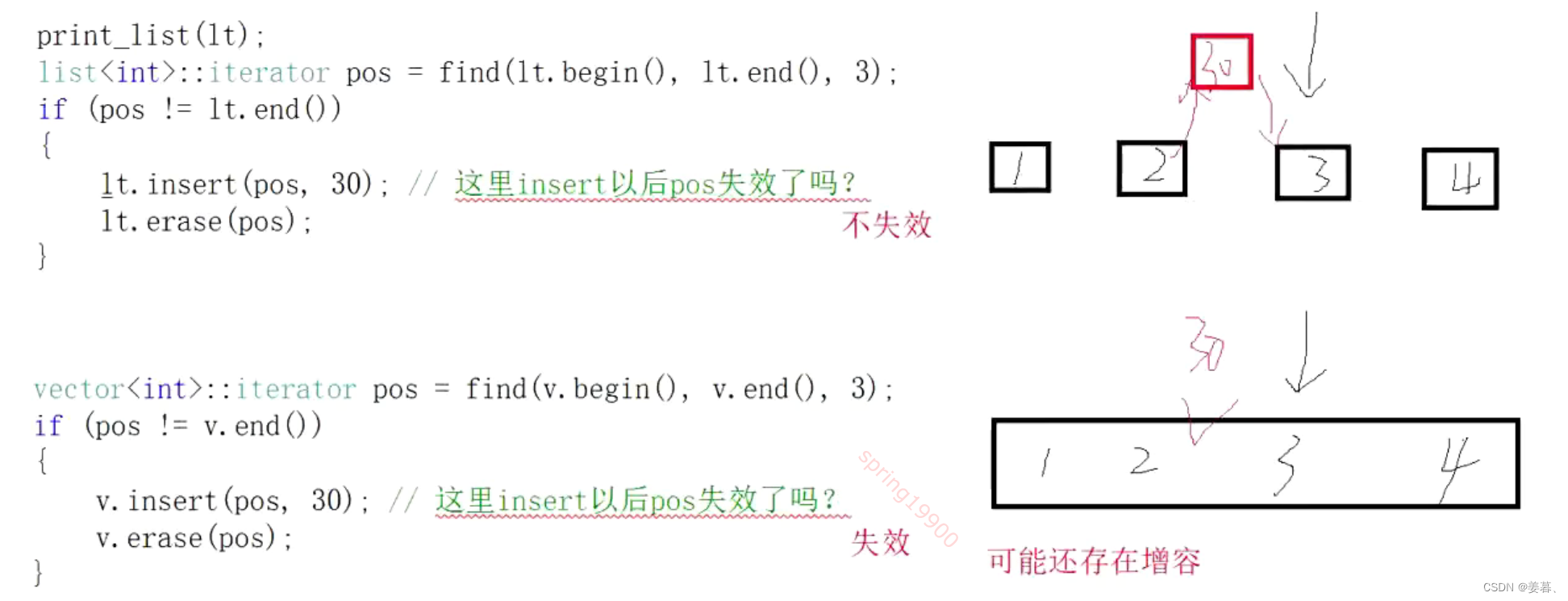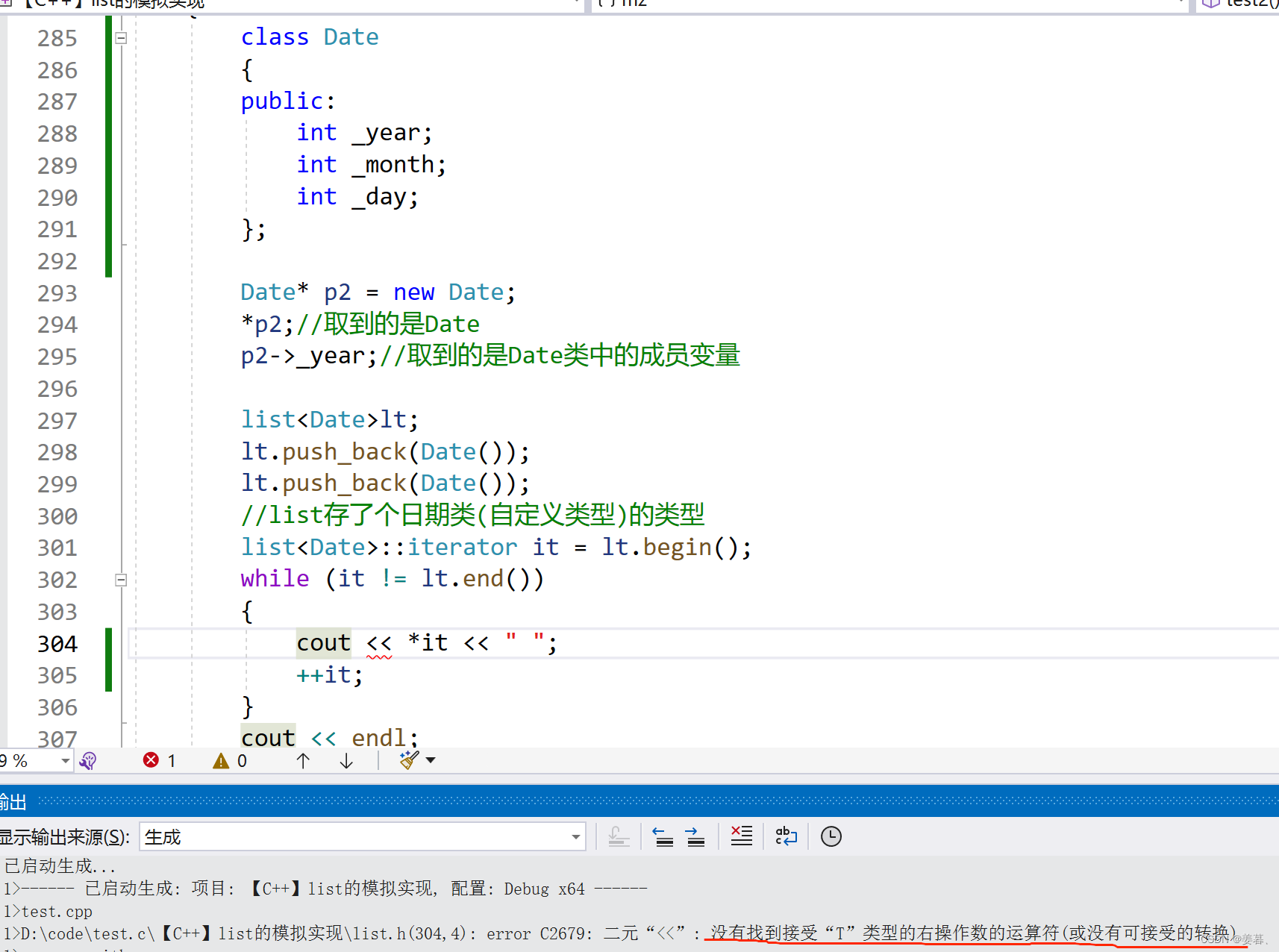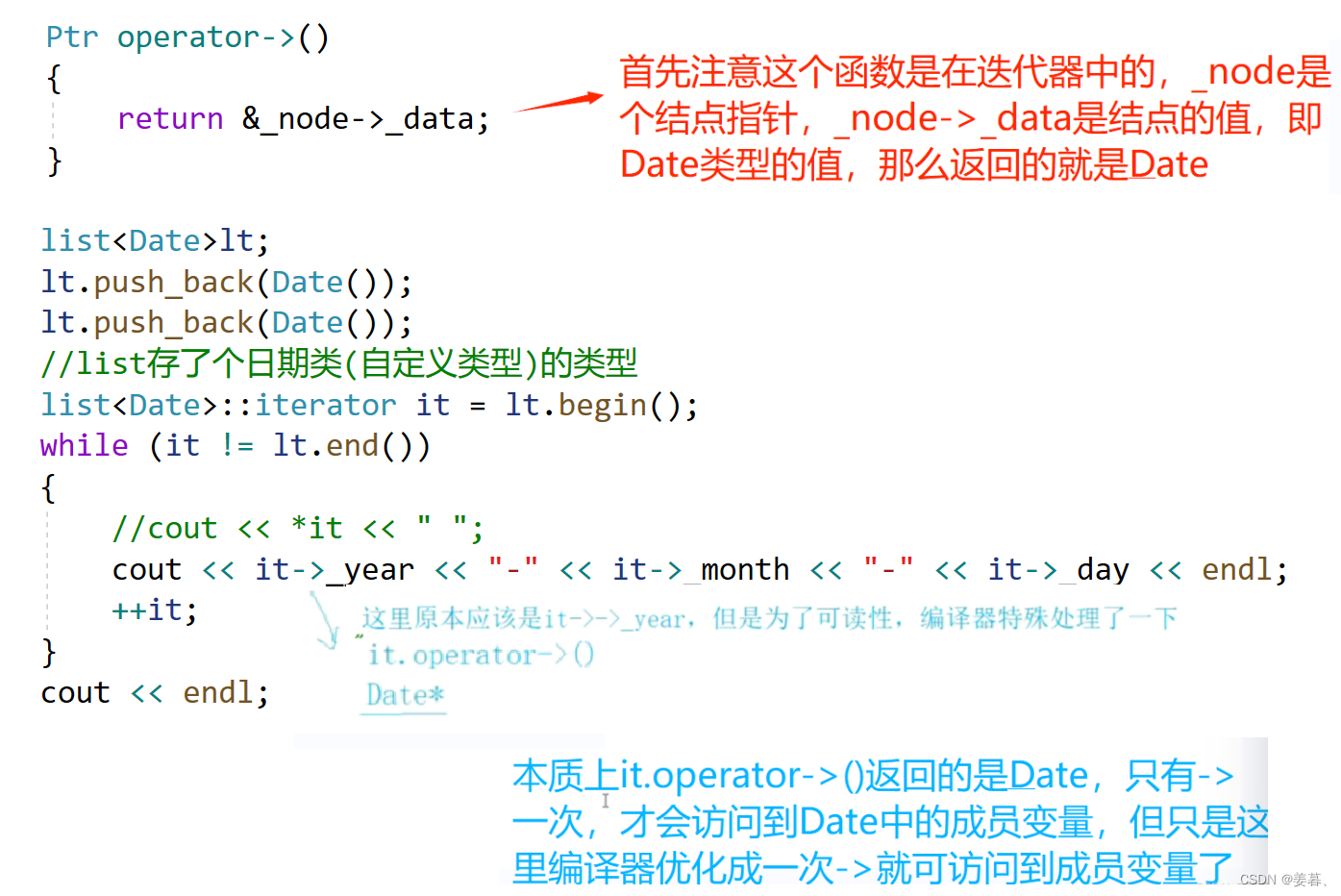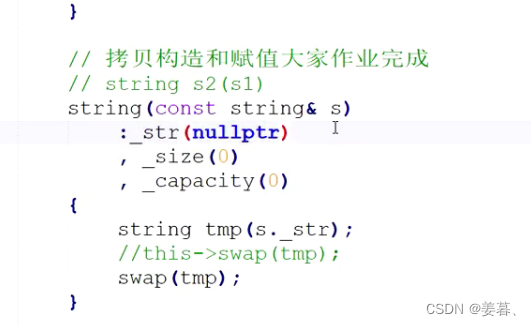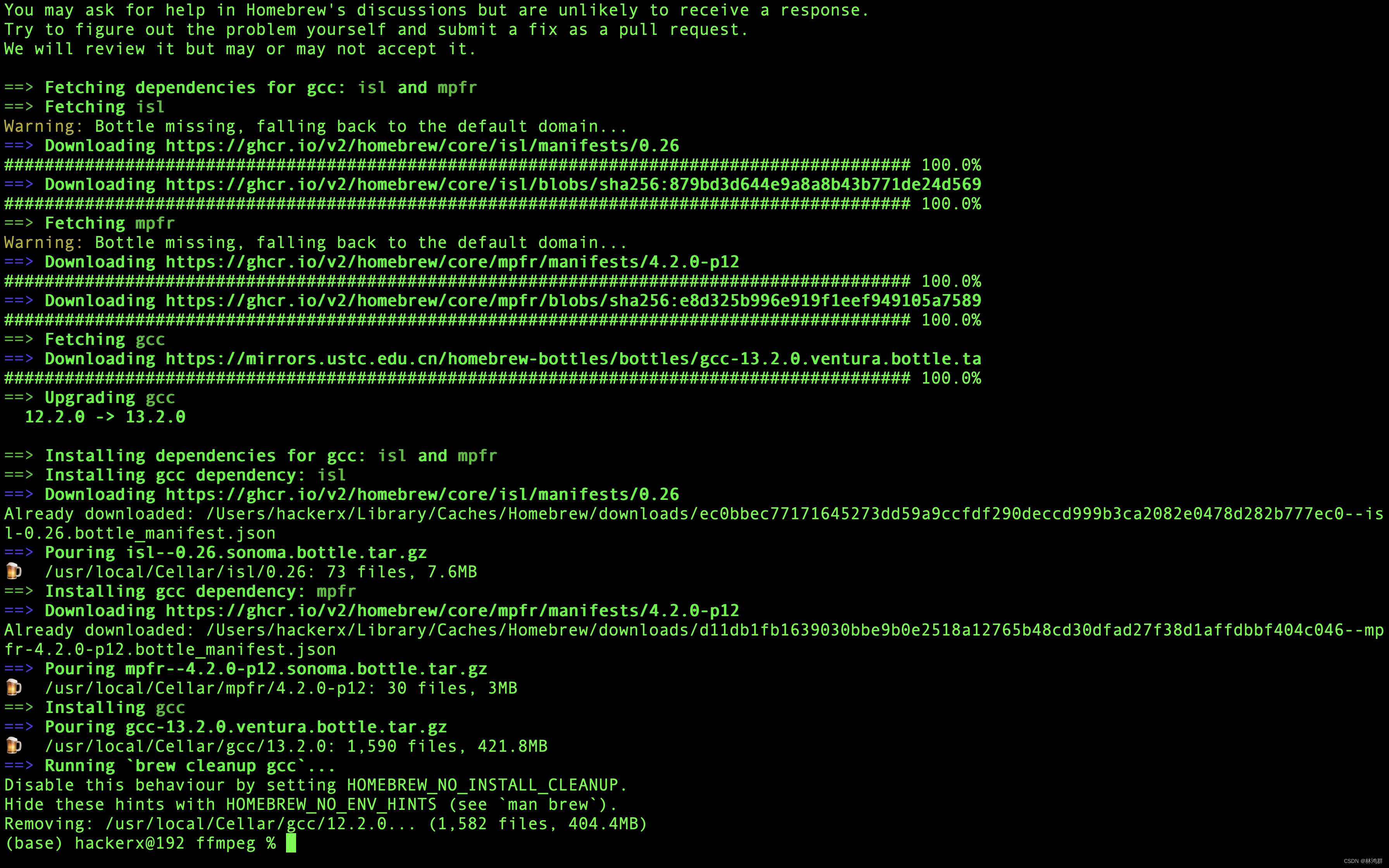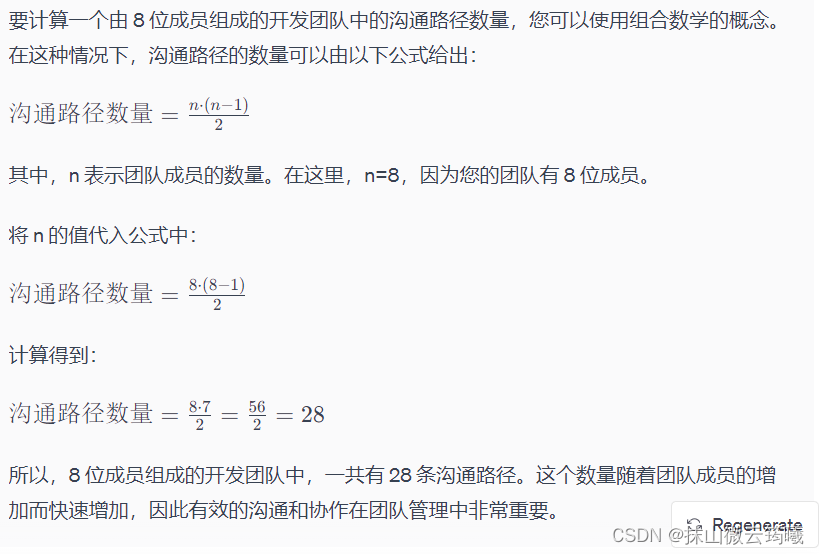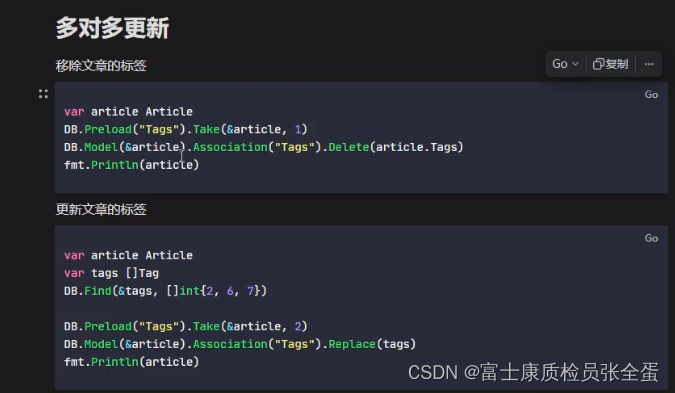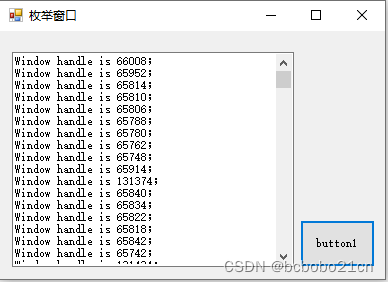
目录
一、list的概念引入
1、vector与list的对比
2、关于struct和class的使用
3、list的迭代器失效问题
二、list的模拟实现
1、list三个基本函数类
2、list的结点类的实现
3、list的迭代器类的实现
3.1 基本框架
3.2构造函数
3.3 operator*
3.4 operator->
3.5 operator前置++和--与后置++和--
3.5 operator==与operator!=
4、list类的实现
4.1 基本框架
4.2 构造函数
4.2 begin()和end()
4.3 拷贝构造
4.4 clear
4.5 operator=
4.6 析构函数
4.7 insert
4.8 push_back 和 push_front
4.9 erase
4.10 pop_back 和 pop_front
三、完整源代码:
list.h:
test.cpp:
一、list的概念引入
1、vector与list的对比
两者的区别十分类似于顺序表和链表的区别
2、关于struct和class的使用
C++中的struct和class的唯一区别在于默认访问限定符(即你不写public、private这种访问限定符)不同,struct默认为公有(public),而class默认为私有(private),一般情况,成员部分私有,部分共有,就用class,所有成员都开放或共有,就用struct
所以下文写的节点和迭代器类都用struct是因为,struct中的成员函数默认为公有了,也不用写public了,但是你用class就要写个public
3、list的迭代器失效问题
list本质:带头双向循环链表
支持操作接口的角度分迭代器的类型:单向(forward_list)、双向(list)、随机(vector)
从使用场景的角度分迭代器的类型:(正向迭代器,反向迭代器)+const迭代器
迭代器失效本质是内存空间的问题,失效原因:
1、增容完还指向旧空间
2、节点已经被释放(list里面)
list的erase迭代器失效
注意:删除不会报错,迭代器失效也不会报错,是删除以后迭代器失效了,是去访问失效的迭代器才会报错
插入知识点(库里面的find实现,可不看)
二、list的模拟实现
1、list三个基本函数类
list本质是一个带头双向循环链表:
模拟实现list,要实现下列三个类:
①、模拟实现结点类
②、模拟实现迭代器的类
③、模拟list主要功能的类
list的类的模拟实现其基本功能(增删等操作)要建立在迭代器类和结点类均已实现好的情况下才得以完成。
2、list的结点类的实现
因为list的本质为带头双向循环链表,所以其每个结点都要确保有下列成员:
- 前驱指针
- 后继指针
- data值存放数据
而结点类的内部只需要实现一个构造函数即可。
//1、结点类 template<class T> struct __list_node//前面加__是命名习惯,一般这么写表示是给别人用的 {//前驱指针和后驱指针__list_node<T>* _next;//C++中可不写struct,直接用名定义,但注意这里还要加类型__list_node<T>* _prev;T _data;//存节点的值//构造函数__list_node(const T& val = T())//给一个缺省值T():_next(nullptr), _prev(nullptr), _data(val){} };①、为什么是__list_node<T>?
首先,C++中用struct定义时可不加struct,重点是这里用了一个类模板,类模板的类名不是真正的类型,即__list_node不是真正的类型,定义变量时__list_node<T>这种才是真正的类型,也就是用类模板定义变量时必须 指定对应的类型
3、list的迭代器类的实现
因为list其本质是带头双向循环链表,而链表的物理空间是不连续的,是通过结点的指针顺次链接,我们不能像先前的string和vector一样直接解引用去访问其数据,结点的指针解引用还是结点,结点指针++还是结点指针,而string和vector的物理空间是连续的,所以这俩不需要实现迭代器类,可以直接使用。
为了能让list像vector一样解引用后访问对应节点中的值,++访问到下一个数据,我们需要单独写一个迭代器类的接口实现,在其内部进行封装补齐相应的功能,而这就要借助运算符重载来完成。
注:迭代器封装后是想模拟指针的行为
3.1 基本框架
template<class T,class Ref,class Ptr> struct __list_iterator {typedef __list_node<T> Node;typedef __list_iterator<T, Ref, Ptr> Self;Node* _node; }①、迭代器类模板为什么要三个参数?
若只有普通迭代器的话,一个class T参数就够了,但因为有const迭代器原因,需要加两个参数,两个参数名Ref(reference:引用)和Ptr(pointer:指针),名字怎么起都行,但这种有意义的名字是很推荐的,即这两个参数一个让你传引用,一个让你传指针,具体等下文讲到const迭代器再说
②、迭代器类到底是什么?
迭代器类就一个节点的指针变量_node,但是因为我们要运算符重载等一系列操作,不得不把list的迭代器写成类,完成那些操作,list的迭代器才能正确的++到下一位置,解引用访问节点的值
③、节点指针和迭代器的区别?
3.2构造函数
//迭代器的构造函数只需要一个指针构造__list_iterator (Node* node):_node(node){ }
3.3 operator*
//*it(调用的是函数,返回节点中的值)Ref operator*(){//出了作用域还在,引用返回return _node->_data;}①、 返回值为什么是Ref?
Ref是模板参数,因为迭代器类的模板参数Ref传入的要么是T&要么是const T&,就是为了const迭代器和普通迭代器的同时实现,底层就是这么实现的,意义就是一个只读,一个可读可写
注:比如之前讲的vector的迭代器,*it(假设it是迭代器变量)就是拿到对应的值,那么list的迭代器也要同理,解引用迭代器就是为了访问对应位置的值,那么list只要通过迭代器返回对应节点的值就好了(*it,我们是就想要对应的值)
3.4 operator->
Ptr operator->(){return &_node->_data;}①、为什么需要operator->?
本质因为自定义类型需要,那需从list存的类型是个自定义类型说起,以Date类型为例
若list存了个自定义类型的Date类,程序错误,因为我们并没有重载Date类的operator<<,若是内置类型的话才可以正常输出,那写一个operator<<重载吗?不,因为你无法确定要用哪些类,也不能每个类都写operator<<,那怎么办?我们访问Date类本质是想访问它内置类型(int)的_year、_month和_day吧,那我们不妨写个专属于自定义类型的operator->(因为内置类型只需要*it就可以直接输出了,但自定义类型不可以直接输出),利用operator->直接访问类的成员变量,而内置类型可以直接输出
故从根源上解决问题: 在迭代器中实现个operator->:
(Ptr是迭代器的模板参数,我们用来作为T*或const T*的)
3.5 operator前置++和--与后置++和--
//++it;(迭代器++本质就是指针往后移,加完后还应是个迭代器)Self& operator++(){_node = _node->_next;return *this;}//it++;Self operator++(int)//加参数以便于区分前置++{Self tmp(*this);//拷贝构造tmp_node = _node->_next;//直接让自己指向下一个结点即可实现++return tmp;//注意返回tmp,才是后置++}//--it;Self& operator--(){_node = _node->_prev;//让_node指向上一个结点即可实现--return *this;}//it--;Self operator--(int)//记得传缺省值以区分前置--{Self tmp(*this);//拷贝构造tmp_node = _node->_prev;return tmp;}①、迭代器++对于list是什么意思?
迭代器++的意思就是想让其指向下一个节点,--正好相反,为了区分前置和后置++(--),我们会用函数重载,也就是多一个“没用的”参数:int,这个参数没什么用,只是为了区分++与--
3.5 operator==与operator!=
//it != end() bool operator!=(const Self& it){//迭代器是否相等只要判断对应节点地址是否相等即可return _node != it._node;}bool operator==(const Self& it){return _node == it._node;}①、两个迭代器怎么比较的?
迭代器中就一个成员变量_node,节点指针,只要比较当前的节点指针是否相同即可,个人认为这个操作意义不大
4、list类的实现
在结点类和迭代器类都实现的前提下,就可实现list主要功能:增删等操作的实现
4.1 基本框架
//3、链表类 template<class T> class list {typedef __list_node<T> Node; public:typedef __list_iterator<T,T&,T*> iterator;typedef __list_iterator<T,const T&,const T*> const_iterator;private:Node* _head;//头结点 }①、const_iterator(const迭代器的介绍)
我们知道const_iterator在begin()和end()中的返回值是需要用到的,其主要作用就是当迭代器只读时使用, 因为普通迭代器和const迭代器的实现区别仅仅在于内部成员函数的返回值不同,难道重写一遍吗?不用,我们模板参数多两个就好了,一个是引用class Ref(T&或const T&),一个是指针class Ptr(T*或const T*),当Ref时const T&就是const迭代器的调用,当Ref时T& 时就是普通迭代器的调用,这就利用模板实现了两个迭代器的同时实现
4.2 构造函数
//带头双向循环链表的构造函数 list() {_head = new Node;_head->_next = _head;_head->_prev = _head; }解释:我们开辟一个头结点,然后使其处于一个对应的初始状态即可
4.2 begin()和end()
iterator begin() {//第一个位置应该是头结点的下一个节点return iterator(_head->_next);//用匿名对象构造iterator类型的 } iterator end() {//最后一个数据的下一个位置应该是第一个节点,即头结点return iterator(_head); }const_iterator begin()const {return const_iterator(_head->_next); } const_iterator end()const {return const_iterator(_head); }①、关于匿名构造的理解
比如 iterator(_head->_next); iterator是个类模板类型(它被typedef过的),那不应该实例化一个对象再构造吗?这里没有用是因为这里是匿名对象的构造,这里这么用比较方便
4.3 拷贝构造
//拷贝构造:传统写法 list(const list<T>& lt) {_head = new Node;//开辟一样的头结点_head->_next = _head;_head->_prev = _head;//1、用迭代器遍历/*const_iterator it = lt.begin();while (it != lt.end()){push_back(*it);++it;}*///2、范围for遍历//遍历lt1,把lt1的元素push_back到lt2里头for (auto e : lt){push_back(e);//自动开辟新空间,完成深拷贝} }解释:list的拷贝构造跟vector不同,它的拷贝是拷贝一个个节点(因为不连续的物理空间), 那么我们可以用迭代器拿到list的一个个节点
①、为什么有的拷贝构造需初始化,operator=不需要?
以string的模拟实现为例
这里为什么s2要初始化?
是因为string的模拟实现有交换操作,而list的传统写法无需交换,开辟一个头结点即可
因为s2是要被拷贝构造出来的,没被拷贝构造前还没存在,然后s2要跟tmp交换,如果也就是tmp得到s2的数据,如果s2之前没初始化,析构销毁就出问题了,因为没初始化是随机值
但是赋值不一样,赋值是两个对象都存在,不存在随机值问题,所以不用一上来就初始化
还有一种现代写法先不介绍
4.4 clear
void clear() {//clear不删除头结点,因为万一删除了头结点你还想插入数据怎么办iterator it = begin();while (it != end()){it = erase(it);} }①、 it = erase(it)什么意思?
防止迭代器失效,因为erase返回的是被删除位置的下一位置,比如删除pos位置的,pos位置被删除后,it都不用动,erase算自动指向下一位置了,故用it接收,若不接收,迭代器失效
4.5 operator=
//赋值运算符重载(传统写法)//lt1 = lt3//list<T>& operator=(const list<T>& lt)//{// if (this != <)// {// clear();//先释放lt1// for (auto e : lt)// push_back(e);// }// return *this;//}//赋值运算符重载(现代写法)//lt1 = lt3list<T>& operator=(list<T> lt)//套用传值传参去拷贝构造完成深拷贝{swap(_head,lt._head);//交换两个list的头结点即可//lt出了作用域,析构函数销毁lt1原来的链表,一举两得//swap(lt);return *this;}注:传统写法要先把被赋值的对象先释放,然后利用push_bak尾插,push_back在下文说明
4.6 析构函数
//析构函数~list(){clear();//删除除头结点以外的节点delete _head;//删去哨兵位头结点_head = nullptr;}
4.7 insert
//insert,插入pos位置之前 iterator insert(iterator pos, const T& x) {Node* newnode = new Node(x);//创建新的结点Node* cur = pos._node; //迭代器pos处的结点指针Node* prev = cur->_prev;//prev newnode cur//链接prev和newnodeprev->_next = newnode;newnode->_prev = prev;//链接newnode和curnewnode->_next = cur;cur->_prev = newnode;//返回新插入元素的迭代器位置return iterator(newnode); }①、返回参数为什么是iterator?
本质是为了防止迭代器失效问题
注:insert指的是插入到指定位置的前面
4.8 push_back 和 push_front
//尾插 void push_back(const T& x) {Node* tail = _head->_prev;//找尾Node* newnode = new Node(x);//创建一个新的结点//_head tail newnode//使tail和newnode构成循环tail->_next = newnode;newnode->_prev = tail;//使newnode和头结点_head构成循环newnode->_next = _head;_head->_prev = newnode;} //头插 void push_front(const T& x) {insert(begin(), x); }
4.9 erase
//erase iterator erase(iterator pos) {assert(pos != end());Node* cur = pos._node;Node* prev = cur->_prev;Node* next = cur->_next;//prev cur next//链接prev和nextprev->_next = next;next->_prev = prev;//delete删去结点,因为每一个节点都是动态开辟出来的delete cur;//返回被删除元素后一个元素的迭代器位置//return next;return iterator(next); }①、 返回值问题
erase的返回值,返回的是被删除位置的下一位置
4.10 pop_back 和 pop_front
//尾删 void pop_back() {erase(--end());//erase(iterator(_head->prev));//构造个匿名对象 } //头删 void pop_front() {erase(begin()); }
最后, list的排序意义不大,因为实际生活中我们都是对数组等排序
三、完整源代码:
list.h:
#pragma oncenamespace mz
{//1、结点类template<class T>struct __list_node//前面加__是命名习惯,一般这么写表示是给别人用的{//前驱指针和后驱指针__list_node<T>* _next;//C++中可不写struct,直接用名定义,但注意这里还要加类型__list_node<T>* _prev;T _data;//存节点的值//构造函数__list_node(const T& val = T())//给一个缺省值T():_next(nullptr), _prev(nullptr), _data(val){}};//2、迭代器类//__list_iterator<T,T&,T*> -> iterator//__list_iterator<T,const T&,const T*> -> const_iteratortemplate<class T,class Ref,class Ptr>struct __list_iterator{typedef __list_node<T> Node;typedef __list_iterator<T, Ref, Ptr> Self;Node* _node;//迭代器的构造函数只需要一个指针构造__list_iterator (Node* node):_node(node){ }//*it(调用的是函数,返回节点中的值)Ref operator*(){//出了作用域还在,引用返回return _node->_data;}Ptr operator->(){return &_node->_data;}//++it;(迭代器++本质就是指针往后移,加完后还应是个迭代器)Self& operator++(){_node = _node->_next;return *this;}//it++;Self operator++(int)//加参数以便于区分前置++{Self tmp(*this);//拷贝构造tmp_node = _node->_next;//直接让自己指向下一个结点即可实现++return tmp;//注意返回tmp,才是后置++}//--it;Self& operator--(){_node = _node->_prev;//让_node指向上一个结点即可实现--return *this;}//it--;Self operator--(int)//记得传缺省值以区分前置--{Self tmp(*this);//拷贝构造tmp_node = _node->_prev;return tmp;}//it != end() bool operator!=(const Self& it){//迭代器是否相等只要判断对应节点地址是否相等即可return _node != it._node;}bool operator==(const Self& it){return _node == it._node;}};//3、链表类template<class T>class list{typedef __list_node<T> Node;public:typedef __list_iterator<T,T&,T*> iterator;typedef __list_iterator<T,const T&,const T*> const_iterator;iterator begin(){//第一个位置应该是头结点的下一个节点return iterator(_head->_next);//用匿名对象构造iterator类型的}iterator end(){//最后一个数据的下一个位置应该是第一个节点,即头结点return iterator(_head);}const_iterator begin()const{return const_iterator(_head->_next);}const_iterator end()const{return const_iterator(_head);}//带头双向循环链表的构造函数list(){_head = new Node;_head->_next = _head;_head->_prev = _head;}//拷贝构造:传统写法list(const list<T>& lt){_head = new Node;//开辟一样的头结点_head->_next = _head;_head->_prev = _head;//1、用迭代器遍历/*const_iterator it = lt.begin();while (it != lt.end()){push_back(*it);++it;}*///2、范围for遍历//遍历lt1,把lt1的元素push_back到lt2里头for (auto e : lt){push_back(e);//自动开辟新空间,完成深拷贝}}//赋值运算符重载(传统写法)//lt1 = lt3//list<T>& operator=(const list<T>& lt)//{// if (this != <)// {// clear();//先释放lt1// for (auto e : lt)// push_back(e);// }// return *this;//}//赋值运算符重载(现代写法)//lt1 = lt3list<T>& operator=(list<T> lt)//套用传值传参去拷贝构造完成深拷贝{swap(_head,lt._head);//交换两个list的头结点即可//lt出了作用域,析构函数销毁lt1原来的链表,一举两得//swap(lt);return *this;}//析构函数~list(){clear();//删除除头结点以外的节点delete _head;//删去哨兵位头结点_head = nullptr;}void clear(){//clear不删除头结点,因为万一删除了头结点你还想插入数据怎么办iterator it = begin();while (it != end()){it = erase(it);}}//尾插void push_back(const T& x){Node* tail = _head->_prev;//找尾Node* newnode = new Node(x);//创建一个新的结点//_head tail newnode//使tail和newnode构成循环tail->_next = newnode;newnode->_prev = tail;//使newnode和头结点_head构成循环newnode->_next = _head;_head->_prev = newnode;}//头插void push_front(const T& x){insert(begin(), x);}//insert,插入pos位置之前iterator insert(iterator pos, const T& x){Node* newnode = new Node(x);//创建新的结点Node* cur = pos._node; //迭代器pos处的结点指针Node* prev = cur->_prev;//prev newnode cur//链接prev和newnodeprev->_next = newnode;newnode->_prev = prev;//链接newnode和curnewnode->_next = cur;cur->_prev = newnode;//返回新插入元素的迭代器位置return iterator(newnode);}//eraseiterator erase(iterator pos){assert(pos != end());Node* cur = pos._node;Node* prev = cur->_prev;Node* next = cur->_next;//prev cur next//链接prev和nextprev->_next = next;next->_prev = prev;//delete删去结点,因为每一个节点都是动态开辟出来的delete cur;//返回被删除元素后一个元素的迭代器位置//return next;return iterator(next);}//尾删void pop_back(){erase(--end());//erase(iterator(_head->prev));//构造个匿名对象}//头删void pop_front(){erase(begin());}private:Node* _head;//头结点};void test1(){list<int>lt;lt.push_back(1);lt.push_back(2);lt.push_back(3);lt.push_back(4);//类外访问迭代器需要指定类域,类内访问可直接访问list<int>::iterator it = lt.begin();while (it != lt.end()){cout << *it << " ";++it;}cout << endl;}struct Date{int _year = 0;int _month = 1;int _day = 1;};void test2(){Date* p2 = new Date;*p2;//取到的是Datep2->_year;//取到的是Date类中的成员变量list<Date>lt;lt.push_back(Date());lt.push_back(Date());//list存了个日期类(自定义类型)的类型list<Date>::iterator it = lt.begin();while (it != lt.end()){//cout << *it << " ";cout << it->_year << "-" << it->_month << "-" << it->_day << endl;++it;}cout << endl;}void print_list(const list<int>& lt){list<int>::const_iterator it = lt.begin();while (it != lt.end()){cout << *it << " ";++it;}cout << endl;}void test3(){list<int>lt1;lt1.push_back(1);lt1.push_back(2);lt1.push_back(3);lt1.push_back(4);list<int> lt2(lt1);print_list(lt2);list<int>lt3;lt3.push_back(10);lt3.push_back(20);lt3.push_back(30);lt3.push_back(40);lt1 = lt3;print_list(lt1);}
}test.cpp:
#include<iostream>
#include<assert.h>
using namespace std;
#include"list.h"int main()
{//mz::test1();mz::test3();return 0;
}
